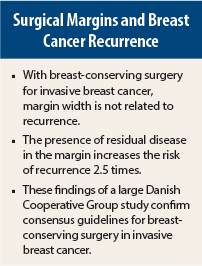The width of the surgical margin doesn’t matter, as long as the margin is negative, according to a large study of breast-conserving surgery in patients with invasive breast cancer.
The risk of ipsilateral breast tumor recurrence was similar for wide negative margins (2–4 mm) or narrow negative margins (0 to < 1 mm) in a large study of 11,900 Danish women who underwent breast-conserving surgery or reexcision, the study found. A final positive margin of any width was associated with a 2.5-fold increased risk of ipsilateral breast tumor recurrence. The study was presented at the 2015 San Antonio Breast Cancer Symposium.1
“We found that the risk of [ipsilateral breast tumor recurrence] was associated with a final positive margin, and local control was not improved with negative margins greater than 1 mm. Residual disease at reexcision increased the risk of [ipsilateral breast tumor recurrence], and overall survival was not affected by repeat surgery,” said presenting author Anne Bodilsen, MD, PhD, of Aarhus University Hospital, Aarhus, Denmark.
Study Details
The study was based on data from 11,900 women aged 18 to 75 years who underwent breast-conserving surgery for unilateral invasive breast cancer and no prior cancer. The women were also treated with radiation therapy and could elect to receive systemic adjuvant treatment.
Median follow-up was 4.9 years. The overall risk of ipsilateral breast tumor recurrence was 2.4% at 5 years and 5.9% at 9 years.
For narrower margins (ie, 0–1 mm), no decreased risk for ipsilateral breast tumor recurrence was observed; the same was true for wider margins (ie, 2–4 mm). A final positive margin increased the risk for ipsilateral breast tumor recurrence 2.5-fold.
Factors associated with increased risk of ipsilateral breast tumor recurrence included younger age (3 times higher risk), more than 4 positive lymph nodes (1.8 times higher) and reexcision (1.5 times higher). The risk of ipsilateral breast tumor recurrence was reduced by chemotherapy (P < .001), and estrogen receptor–positive disease treated with hormonal therapy (P < .001).
Seventeen percent of patients had repeat surgery: 11% reexcision and 6% mastectomy. Among these patients, 20% had residual disease in the surgical sample: 23% with invasive carcinoma, 63% with ductal carcinoma in situ, and 14% with both.
The presence of residual disease following reexcision increased the risk of ipsilateral breast tumor recurrence between 2.5- and 3-fold. Although reexcision increased the risk for ipsilateral breast tumor recurrence, Dr. Bodilsen pointed out that this was because negative margins were not obtained at reexcision. ■
Disclosure: Dr. Bodilsen reported no potential conflicts of interest.
Reference
1. Bodilsen A, Bjerre K, Offersen BV, et al: Importance of margin width and reexcision in breast conserving treatment of early breast cancer: A Danish Breast Cancer Cooperative Group study of 11,900 women. 2015 San Antonio Breast Cancer Symposium. Abstract S2-01. Presented December 9, 2015.



